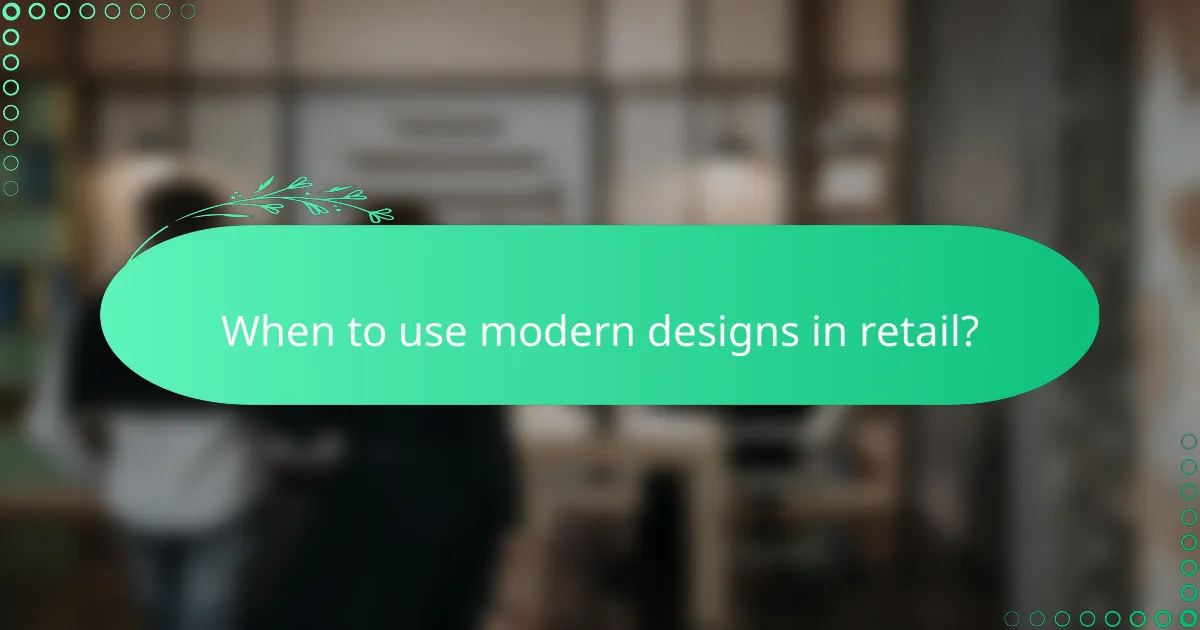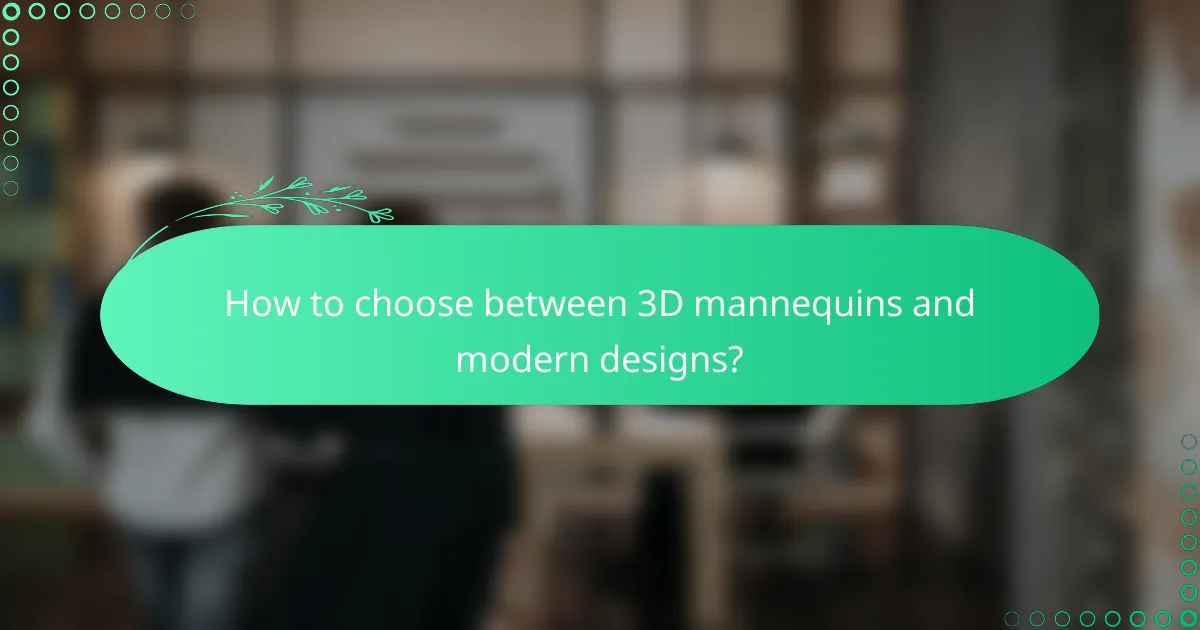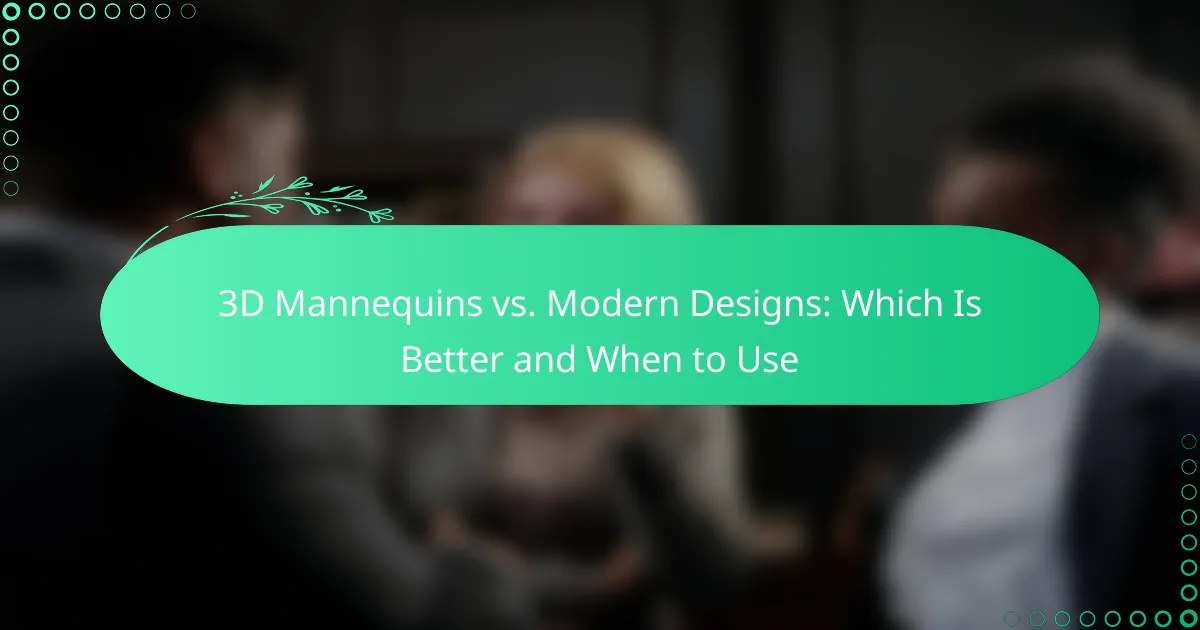In the world of retail, the choice between 3D mannequins and modern designs can significantly impact customer engagement and sales. 3D mannequins provide a lifelike representation of products, enhancing visual merchandising, while modern designs emphasize flexibility and branding, adapting seamlessly to various store layouts. Understanding the strengths of each option is essential for retailers aiming to create an appealing shopping experience.

When to use 3D mannequins in retail?
3D mannequins are particularly useful in retail when aiming to enhance visual merchandising and customer interaction. They are ideal for showcasing products in a lifelike manner, making them a valuable tool for attracting shoppers and improving sales.
Enhanced customer engagement
Using 3D mannequins can significantly boost customer engagement by creating an interactive shopping experience. Shoppers are more likely to explore products that are displayed in a dynamic and appealing way, which can lead to increased foot traffic and longer store visits.
Consider incorporating technology, such as augmented reality, with 3D mannequins to allow customers to visualize products in real-time. This can enhance their connection to the merchandise and encourage purchases.
Realistic product representation
3D mannequins provide a realistic representation of how clothing or accessories will look when worn. This can help customers make informed decisions, reducing the likelihood of returns due to dissatisfaction with fit or style.
For example, a clothing retailer can use 3D mannequins to display outfits in various poses, showcasing the versatility of the garments. This approach can effectively highlight key features and attract more buyers.
Cost-effective for small businesses
For small businesses, 3D mannequins can be a cost-effective solution compared to traditional display methods. They require less physical space and can be reused for different product lines, reducing overall display costs.
Investing in a few high-quality 3D mannequins can yield significant returns by enhancing product visibility and customer interest. Small retailers should consider their budget and the potential for increased sales when deciding to implement this strategy.

When to use modern designs in retail?
Modern designs are ideal for retail environments that prioritize flexibility, branding, and efficient use of space. These designs can adapt to various product types and store layouts, making them suitable for dynamic retail settings.
Flexible display options
Modern designs offer a range of display options that can be easily adjusted to showcase different products. Retailers can use modular fixtures that allow for quick reconfiguration, accommodating seasonal changes or promotional events. This adaptability helps maintain customer interest and enhances the shopping experience.
For example, a clothing store might use adjustable shelving to display new arrivals prominently while easily shifting items for clearance sales. This flexibility can lead to improved sales by keeping the layout fresh and engaging.
Customizable for branding
Modern designs can be tailored to reflect a brand’s identity, creating a cohesive shopping environment. Retailers can choose colors, materials, and layouts that align with their brand image, making it easier to communicate their values and style to customers.
For instance, a high-end fashion brand might opt for sleek, minimalist displays that emphasize luxury, while a vibrant, youth-oriented brand could use bold colors and playful shapes. Customization helps reinforce brand recognition and loyalty among shoppers.
Space-efficient solutions
Space efficiency is a crucial consideration in retail design, especially in urban areas where square footage can be costly. Modern designs often incorporate multi-functional furniture and vertical displays, maximizing the use of available space.
Retailers can utilize wall-mounted racks or tiered shelving to display products without occupying valuable floor space. This approach not only enhances product visibility but also creates a more open and inviting shopping atmosphere.

What are the key differences between 3D mannequins and modern designs?
3D mannequins and modern designs differ primarily in their visual representation and functionality. While 3D mannequins offer a realistic and versatile display option, modern designs often focus on minimalism and artistic expression.
Visual impact and realism
3D mannequins provide a high level of realism, making them ideal for showcasing clothing in a lifelike manner. They can be customized in terms of body shape, skin tone, and pose, allowing retailers to create a relatable shopping experience.
In contrast, modern designs may prioritize artistic elements over realism. These displays can be abstract or stylized, which may appeal to specific brands aiming for a unique aesthetic rather than a direct representation of the product.
Cost and maintenance
3D mannequins typically involve higher initial costs due to their detailed design and customization options. However, they can be a worthwhile investment as they often require less frequent replacement and can adapt to various seasonal collections.
Modern designs, while generally more affordable, may require more frequent updates or replacements to keep the display fresh and engaging. Retailers should weigh the initial costs against long-term maintenance when deciding which option to pursue.
Target audience appeal
The choice between 3D mannequins and modern designs should align with the target audience’s preferences. For example, brands targeting younger, fashion-forward consumers may benefit from the realism of 3D mannequins to create a relatable shopping experience.
Conversely, brands aiming for a more artistic or niche market might find that modern designs resonate better with their audience, allowing them to stand out in a crowded marketplace. Understanding the audience’s values and expectations is crucial in making the right choice.

How to choose between 3D mannequins and modern designs?
Choosing between 3D mannequins and modern designs depends on your store’s specific needs, layout, and target audience. Each option has unique advantages that can enhance customer engagement and sales when used appropriately.
Assessing store layout
Your store layout plays a crucial role in determining whether to use 3D mannequins or modern designs. For spacious environments, 3D mannequins can create striking visual displays that draw attention from afar. In contrast, smaller stores may benefit from modern designs that maximize space and allow for more flexible arrangements.
Consider the flow of customer traffic as well. If your layout encourages customers to move through specific paths, integrating 3D mannequins at key points can enhance visibility and engagement. Alternatively, modern designs can be strategically placed to complement the layout without overwhelming the space.
Understanding customer demographics
Knowing your customer demographics is essential in deciding between 3D mannequins and modern designs. If your target audience includes younger, tech-savvy shoppers, modern designs that incorporate digital elements may resonate more effectively. On the other hand, traditional shoppers might respond better to the classic appeal of 3D mannequins.
Additionally, consider cultural factors. In regions where visual merchandising is highly valued, such as in major urban centers, 3D mannequins might be more impactful. In contrast, more minimalist markets may prefer modern designs that reflect simplicity and sophistication.
Evaluating marketing goals
Your marketing goals should guide your choice between 3D mannequins and modern designs. If your aim is to create a strong brand presence and showcase new collections, 3D mannequins can effectively highlight products in an eye-catching way. They can be dressed in the latest styles, making them ideal for seasonal promotions.
Conversely, if your focus is on creating an immersive shopping experience or promoting interactivity, modern designs may be the better option. These can include digital displays or augmented reality features that engage customers and encourage them to explore more. Always align your visual merchandising strategy with your overall marketing objectives for the best results.

What are the benefits of using 3D mannequins?
3D mannequins offer several advantages for retailers, including enhanced visual appeal and the ability to create immersive shopping experiences. They can effectively showcase products in a way that traditional displays cannot, leading to increased customer engagement and satisfaction.
Increased sales conversion rates
Utilizing 3D mannequins can significantly boost sales conversion rates by providing customers with a more realistic view of how products will look when worn. This lifelike representation often encourages impulse purchases, as shoppers can better visualize the fit and style of items.
Retailers have reported conversion increases ranging from 10% to 30% when implementing 3D displays, making them a valuable tool for driving sales. Ensuring that the mannequins are styled in line with current trends can further enhance this effect.
Improved brand storytelling
3D mannequins allow brands to tell a story through visual merchandising, creating a narrative that resonates with customers. By incorporating lifestyle elements and thematic displays, retailers can evoke emotions and connect with their audience on a deeper level.
For instance, a clothing brand might use 3D mannequins to depict a seasonal theme, such as summer beachwear, which can enhance customer experience and brand loyalty. This storytelling approach can differentiate a brand in a crowded market.
Versatile display capabilities
3D mannequins offer versatile display options that can adapt to various retail environments and product types. They can be customized in size, pose, and even color to match specific branding needs or seasonal promotions.
Retailers can easily switch out outfits and accessories on 3D mannequins, allowing for quick updates to displays without significant investment. This flexibility makes them suitable for both high-end boutiques and larger department stores, accommodating diverse merchandising strategies.

What are the drawbacks of using modern designs?
Modern designs can lack the versatility and realism that 3D mannequins provide. While they may offer a sleek aesthetic, they often fall short in functionality and adaptability for various display needs.
Limited Realism
Modern designs often prioritize style over realism, which can be a drawback in retail environments where customer engagement is key. Unlike 3D mannequins that can mimic human proportions and poses, modern designs may appear flat or abstract, failing to attract attention.
Higher Production Costs
Creating modern designs can involve higher production costs due to the materials and technology used. For instance, custom designs may require advanced manufacturing techniques, which can lead to significant expenses compared to traditional mannequins.
Less Versatile
Modern designs may not be as versatile as 3D mannequins, which can be adjusted for different displays or styles. Retailers may find themselves limited in how they can showcase their products, leading to a less dynamic shopping experience.
Potential for Obsolescence
Trends in design can change rapidly, making modern designs susceptible to becoming outdated. Retailers investing in contemporary styles may need to frequently update their displays to stay relevant, adding to long-term costs.
